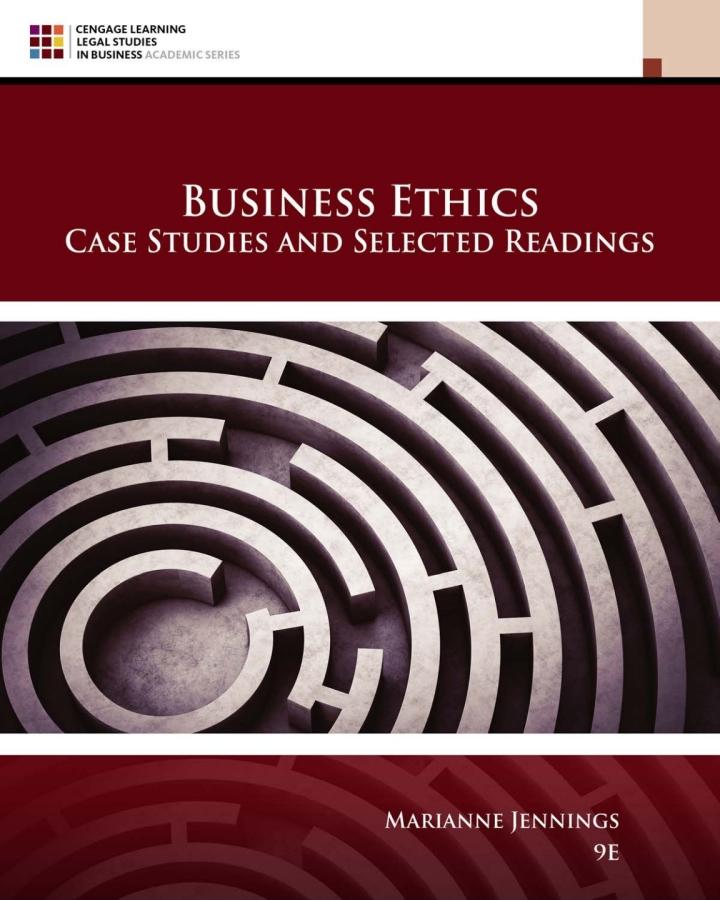In 1982, 23-year-old Diane Elsroth died after taking a Tylenol capsule laced with cyanide. Within five days
Question:
In 1982, 23-year-old Diane Elsroth died after taking a Tylenol capsule laced with cyanide. Within five days of her death, seven more people died from taking tainted Tylenol purchased from stores in the Chicago area.
At that time, Tylenol generated \$525 million per year for McNeil Consumer Products, Inc., a subsidiary of Johnson \& Johnson. The capsule form of the pain reliever represented \(30 \%\) of Tylenol sales. McNeil's marketing studies indicated that consumers found the capsules easy to swallow and believed, without substantiation, that Tylenol in capsule form worked faster than Tylenol tablets.
The capsule's design, however, meant they could be taken apart, tainted, and then restored to the packaging without evidence of tampering. After the Chicago poisonings, which were never solved, McNeil and Johnson \& Johnson executives were told at a meeting that processes for sealing the capsules had been greatly improved, but no one could give the assurance that they were tamperproof.
The executives realized that abandoning the capsule would give their competitors, Bristol-Myers (Excedrin) and American Home Products (Anacin), a market advantage, plus the cost would be \(\$ 150\) million just for 1982. Jim Burke, then-CEO of Johnson \& Johnson, told the others that without a tamperproof package for the capsules, they would risk the survival of not only Tylenol but also Johnson \& Johnson. The executives decided to abandon the capsule.
Frank Young, a Food and Drug Administration (FDA) commissioner, stated at the time, "This is a matter of Johnson \& Johnson's own business judgment, and represents a responsible action under tough circumstances." 20 Johnson \& Johnson quickly developed "caplets"-tablets in the shape of a capsule-and then offered consumers a coupon for a bottle of the new caplets if they turned in their capsules. Within five days of the announcement of the capsule recall and caplets offer, 200,000 consumers had responded. Johnson \& Johnson had eliminated a key product in its lineone that customers clearly preferred-in the interest of safety. Otto Lerbinger of Boston University's College of Communication cited Johnson \& Johnson as a "model of corporate social responsibility for its actions."21..............
Discussion Questions
1. Were the shareholders' interests ignored in the decision to take a \(\$ 150\) million write-off and a possible loss of \(\$ 525\) million in annual sales by abandoning the capsules?
2. Suppose that you were a Tylenol competitor. Would you have continued selling your capsules?
3. Was Mr. Burke's action a long-term decision? Did it take into account the interests of all stakeholders? How did Mr. Burke's action help the company with the liver-damage issues? Mr. Burke, who served as Johnson \& Johnson's CEO from 1970-1989, died on October 1, 2012. A full-page ad in the Wall Street Journal on October 2, 2012, read, "What you taught us will live on, In fond memory of James E. Burke." \({ }^{38}\) Have Burke's teachings survived?
4. What can you conclude from the quick development and appearance of the new product line?
5. Following the 2010 misstep, Tylenol's competitors sent out free samples and coupons to Tylenol customers who participated in the Tylenol recall as a way of getting them to try their products. Why would such a campaign at this time result in more sales of their products? What is different about this issue versus the cyanide poisonings? Make a list of the distinctions between the two series of events, including descriptions of company and customer responses.
6. General Robert Wood Johnson, the CEO of Johnson \& Johnson from 1932 to 1963, wrote a credo for his company that states the company's first responsibility is to the people who use its products and services; the second responsibility is to its employees; the third, to the community and its environment; and the fourth, to the stockholders. \({ }^{39}\) Did Johnson \& Johnson follow its credo?
7. Why did the company drag its heels on the later recalls? What was the purpose of the phantom contractor and the resulting unannounced recall?
8. Did the company ride the coattails of its recall recognition from the 1987 poisonings for too long? Was hubris involved?
9. A lawyer who represents clients suing McNeil offered the following observations: "It [McNeil] markets itself as a company that takes children's safety very seriously and that's why they can charge a premium price for the Tylenol. People are willing to pay a premium price because of a reputation for safety. Now they're being deceived." 40 Another lawyer who represents companies before the FDA added, "The value of the brand is such that that's got to be the first thought." "41 What thoughts are the lawyers offering on cost analysis in ethical issues through their experiences and observations?
Step by Step Answer:

Business Ethics Case Studies And Selected Readings
ISBN: 9780357453865
9th Edition
Authors: Marianne M. Jennings





